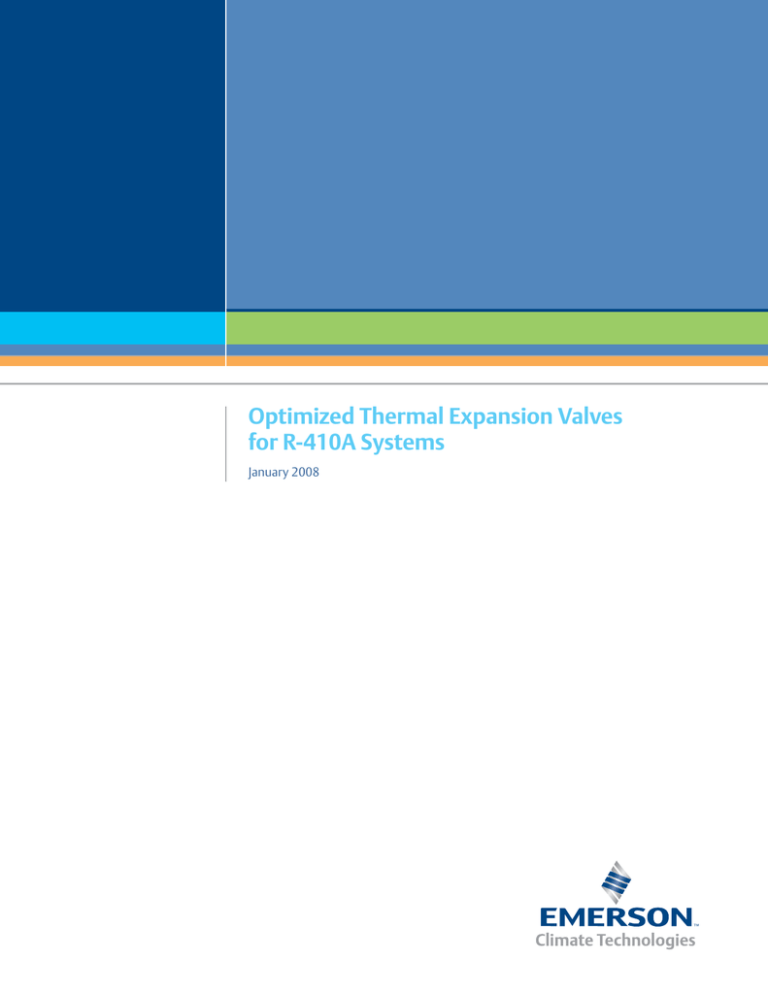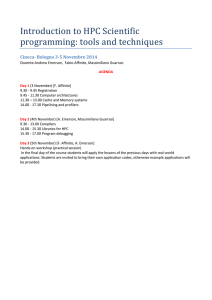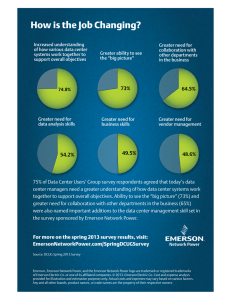
Optimized Thermal Expansion Valves
for R-410A Systems
January 2008
Overview
Introduction
By 2010, the United States must phase out ozone-depleting refrigerants and
transition to hydrofluorocarbon (HFC) refrigerants like R-410A for new heating,
ventilation and air conditioning (HVAC) systems. The change to R-410A has
initiated a redesign of HVAC systems, and thermal expansion valves (TXVs)
designed to operate with the higher-pressure R-410A refrigerant are needed.
To meet this need, Emerson Climate Technologies has developed the
Emerson® C-Series Thermal Expansion Valve, the first TXV designed and
optimized specifically for use in R-410A systems. This paper explains how
the C-Series TXV can provide significant advantages for air conditioning
and heat-pump applications.
Contents
This paper contains the following topics:
Topic
Page
Recent HVAC market changes ..................................................................1
Functions of expansion devices ................................................................3
TXVs and R-410A applications ..................................................................4
Characteristics of Emerson® C-Series Thermal Expansion Valves ................5
Optimized control for R-410A pressure-temperature curve ................5
Improved internal check valves for greater system efficiency ..............7
Improved TXV reliability ....................................................................9
Computerized manufacturing process controls to improve quality....10
Conclusion ..............................................................................................10
About Emerson Climate Technologies ......................................................11
About the authors and contributors to this paper ....................................12
Authors ............................................................................................12
Contributors ....................................................................................13
Recent HVAC market changes
SEER legislation
Prior to the 13 SEER (Seasonal Energy Efficiency Ratio) regulations that took
effect in 2006, most HVAC systems used fixed-orifice devices. Since then
virtually all residential systems have been redesigned for the higher efficiency
standards. As a result:
• Indoor and outdoor coils have increased in size
• More efficient compressors are being used
• TXVs have replaced fixed-orifice devices
Trends in HVAC system
efficiency
Figure 1 shows the marketplace’s transition from 10, 11 and 12 SEER to the
more energy-efficient 13 SEER equipment required as of January 23, 2006.
Figure 1
Transition to 13 SEER Timeline
14+ SEER
100
% of market
80
12 SEER
13 SEER
60
40
10 and 11 SEER
20
0
2002
Upcoming refrigerant
change
2003
2004
2005
2006
In 2010, the United States, in accordance with the Montreal Protocol, must
phase out all ozone-depleting, chlorine-based refrigerants on new equipment.
By 2010, common ozone-depleting hydrochlorofluorocarbon (HCFC)
refrigerants like R-22 will transition to HFC refrigerants like R-410A and R-404A,
for air conditioning and refrigeration systems.
Continued on next page
1
Recent HVAC market changes (continued)
R-410A conversion by 2010
Figure 2 shows that by 2010, all new HVAC systems will be required to use HFC
refrigerants like R-410A.
Figure 2
R-410A Conversion Timeline
100
R-410A (HFC)
% of market
80
60
R-22 (HCFC)
40
20
0
2002
Effects of refrigerant
change
2
2004
2006
2008
2010
The change to R-410A has initiated another redesign for HVAC systems. Coils,
compressors and TXVs designed to operate with the higher-pressure R-410A
refrigerant are needed. Growing consumer interests in energy conservation
and environmental issues are contributing to product and system changes as
well. As a result, the market is trending toward more efficient, high-SEER
systems with dual- or variable-speed fans and compressors.
Functions of expansion devices
TXV function
Thermal expansion valves (TXVs) are precision devices designed to regulate
the rate of refrigerant-liquid flow into the evaporator of a refrigeration or air
conditioning system. These valves meter the refrigerant’s flow rate in exact
proportion to the rate of evaporation of the refrigerant in the evaporator.
Disadvantage of past
systems
In pre-13 SEER systems, which used a fixed-orifice device, the flow rate was a
function of the pressure differential across it. Consequently the orifice had to
be chosen or optimized at one particular operating condition. As the ambient
temperatures changed, the discharge and suction pressures also changed,
resulting in flow rates through the orifice that were no longer optimized for
these new conditions.
Advantages of using TXVs
A thermal expansion valve, however, does not suffer from this disadvantage. A
TXV opens and closes in response to the superheat at the evaporator outlet.
As a result, it adjusts its flow rate to balance with the actual load and
operating conditions. This enables systems with TXVs to operate at ideal
efficiency levels, regardless of operating conditions.
In addition, the TXV closes tightly when the compressor is not operating. This
prevents pressure equalization during the off cycle, allowing the system to
return to optimum efficiency more quickly when the compressor is restarted.
It also leads to additional energy-efficiency gains.
TXV location
Figure 3 shows the location of the thermal expansion valve in an air
conditioning system.
Figure 3
3
TXVs and R-410A applications
Changes to original designs
The first TXVs used in systems with R-410A refrigerant were based largely on
platforms originally designed for older systems using R-22 refrigerant. To make
these valves suitable for R-410A, the most common design changes were
aimed only at meeting higher mechanical-strength requirements. Typical
changes included:
• Increasing power-element thickness
• Adding diaphragms to the power element
• Modifying the sensing-bulb charge to suit R-410A temperature/pressure
characteristics
Designs not optimized
Although these changes made the TXVs suitable for use with R-410A systems,
the performance of these valves was not optimized, which resulted in
compromised system performance.
New optimized design
Due to the need for an optimized TXV for use with R-410A refrigerant,
Emerson has developed the first TXV designed specifically for R-410A. The
C-Series TXV is a performance solution for residential and light commercial
R-410A applications.
4
Characteristics of Emerson® C-Series Thermal Expansion Valves
Optimized control for R-410A pressure-temperature curve
Unique operating
characteristics of R-410A
The unique characteristics of the R-410A refrigerant were the key
consideration in the design of the C-Series TXV. These characteristics include
operational pressures typically 50 percent higher than R-22. Most existing
TXV designs are adequate for these higher pressures; however, another
characteristic of R-410A, the pressure-temperature curve, requires significant
attention in the design of the TXV, to ensure that the system operates
efficiently. The pressure differential for R-410A refrigerant at normal
evaporator operating temperatures (40 degrees Fahrenheit to 47 degrees
Fahrenheit) is about 16.7 pounds per square inch gauge (psig), versus about
10.6 psig for R-22.
Pressure-temperature
curves comparison
Figure 4 compares the pressure differentials (or pressure-temperature curves)
for R-410A and R-22.
Figure 4
Pressure Differentials for R-410A and R-22
130
16.7 psig Δ
Pressure (psig)
120
110
R-410A
100
R-22
90
80
10.6 psig Δ
70
60
38
40
42
44
Temperature ( OF)
46
48
Continued on next page
5
Optimized control for R-410A pressure-temperature curve (continued)
Problems with other TXVs
TXVs that were originally designed for the R-22 pressure-temperature curve
will respond too quickly to changes in evaporator temperature and pressure,
when used with R-410A.
This fast-response characteristic typically leads to superheat hunting. When
the evaporator superheat is unstable, a lack of heat transfer from the incoming
air to the coil leads to longer run times – to satisfy the thermostat settings –
and loss of system efficiency.
Performance benefits of
C-Series TXV
The C-Series TXV, designed specifically for R-410A applications, will have
faster evaporator pulldown and more stable superheat, keeping the optimal
amount of liquid refrigerant in the evaporator during operation. Having the
optimal amount of refrigerant in the coil makes the transfer of latent and
sensible heat from the incoming air to the coil much more efficient.
Due to these efficiency gains, original equipment manufacturers (OEMs) may
be able to design systems with smaller coils or less system charge.
C-Series TXV versus other
TXVs’ superheat control
Figure 5 compares superheat stability on a five-ton indoor coil, before and
after the originally specified TXV was replaced with a C-Series TXV.
Figure 5
C-Series TXV Superheat Stability
Before: Competitive TXV
After: Emerson C-Series TXV
14
O
F
12
10
8
2.2O evaporator superheat hunting
1.2O evaporator superheat hunting
4:30 p.m. 4:35 p.m. 4:40 p.m. 4:45 p.m. 4:50 p.m. 4:55 p.m. 11:30 p.m. 11:35 p.m. 11:40 p.m. 11:45 p.m. 11:50 p.m. 11:55 p.m.
Compressor protection
6
In addition to the performance benefits, tighter evaporator superheat control
ensures consistent superheat at the compressor inlet, preventing damage
that can result from incondensable liquid’s and/or high-temperature gas’s
entering the compressor.
Improved internal check valves for greater system efficiency
Introduction
A key consideration when designing a TXV for split-system heat-pump
applications is the performance of the internal check valve.
How check valves function
inside TXVs
On the indoor coil, check valves are closed in cooling mode and open in
heating mode, to allow reverse refrigerant flow through the TXV. These check
valves must have low seat leakage, for good Coefficient of Degradation (Cd)
performance, and must flow freely when the flow is reversed, to maintain
system capacity and efficiency.
Design options
There are various check-valve designs in service: Some use check balls; some
use plungers with o-ring seals; and others incorporate nylon slides that act as
check mechanisms. The C-Series TXV has a patent-pending check-plate design
that is more temperature, chemical and wear resistant than competing
designs. Most important, it has 60 percent more flow at a two psig pressure
drop than the nearest competitive model.
Increased system efficiency
The potential benefits of maximizing flow (or reducing pressure drop)
through the TXV’s check valve are increased system efficiency and reduced
applied costs. Some heat pumps feature external check valves, to maximize
refrigerant flow around the TXV in an effort to improve system efficiency.
Laboratory tests have shown that SEER gains of 0.5 are possible, when
replacing the competitive TXV and the external check valve with a C-Series
TXV with internal check valves.
Continued on next page
7
Improved internal check valves for greater system efficiency (continued)
C-Series TXV vs. nearest
competitor’s
Figure 6 shows that the Emerson C-Series TXV provides increased reverse flow,
which contributes to increased system efficiency.
Figure 6
C-Series TXV Increased Reverse Flow
8
Emerson C-Series TXV
7
Nearest competitor
R-410A flow (tons)
6
5
4
3
2
1
0
0
2
4
6
8
10
12
Pressure drop (psig)
Reduced costs
8
Using a C-Series TXV may help OEMs reduce applied costs. As previously
discussed, due to its increased reverse-flow capacity, the C-Series TXV may
eliminate the need for external check valves. In addition, the increased reverseflow capacity, in combination with the C-Series TXV’s superior superheat
control, may allow OEMs to use less indoor and outdoor coil and less refrigerant.
Improved TXV reliability
Reliability expectations
In addition to designing a TXV tailored to the unique pressure-temperature
characteristics of R-410A refrigerant and incorporating check valves with
greater reverse-flow capacity, it is essential that the TXV be reliable. Due to
increased usage of TXVs, there is greater focus on reducing first-year failures
in the field. It is the industry expectation that factory-installed TXVs last for
the life of the system.
Most common
failure mode
The most common failure mode found in field-returned TXVs is loss of powerelement charge, which causes the system to lose cooling capacity. Typically
charge is lost when it leaks out of the various brazed and crimped joints in the
sensing-bulb tube or from cracks in the diaphragm.
Preventing loss of powerelement charge
Proper TXV design and manufacturing processes can affect the sensing-bulb
assembly’s leak resistance and the diaphragm’s fatigue resistance. The loss
of power-element charge through the sensing bulb’s various joints can be
addressed through the proper design of brazing, crimping and charge-leak
testing processes. In addition, automated brazing processes used in the
assembly of the C-Series TXV minimize porosity and metallurgical changes
in the copper, to help prevent charge leaks.
In addition to taking steps to prevent charge leaks from occurring, TXV
manufacturers can take strides to improve detection of charge leaks,
by installing equipment that detects primary power-element charge
constituents, rather than trace gases added for leak-detection purposes.
Preventing fatigue failures
A comprehensive test of competitive TXVs and finite element analysis has
reinforced the proposition that TXVs with embossed (convoluted) diaphragms,
such as the C-Series TXV, are less susceptible to fatigue failures. The convolution
effectively moves the diaphragm’s flex points farther away from the heataffected zone of the power element’s weld joint.
In addition, the size of the heat-affected zone is directly attributed to the type
of welding process used. Tungsten inert gas (TIG)- and plasma-welding
processes have much larger heat-affected zones than laser-welding; thus,
TIG- and plasma-welding processes theoretically yield lower reliability results
than laser-welding.
9
Computerized manufacturing process controls to improve quality
Introduction
To ensure the initial quality of complex control devices like TXVs, manufacturing
processes must be designed to eliminate variation in key valve characteristics.
Problems with
conventional processes
Conventional TXV manufacturing processes tend to be dependent on the
operators to install the correct parts, use the correct test parameters and apply
the correct labels to the valve. Operator-dependent processes create more
variation in valve performance, more OEM line rejects and higher first-year field
service claims than are tolerable in today’s business environment.
C-Series TXV
manufacturing process
controls
The C-Series TXV manufacturing process is electronically controlled and
integrated, to minimize the impact that operators have on outgoing quality.
Critical steps in manufacturing processes include seat-leak testing, charge-leak
testing and static-superheat setting. These steps and others are controlled by
a fully integrated serialized numbering system that automatically inputs test
parameters to the equipment, based on each TXV’s unique specifications.
This serialized numbering system ensures that critical operations on each valve
are successfully completed, before applying the product information to the
power element.
Automatic quality
verification
At the end of the manufacturing process, the integrated database system
confirms that the valve has passed all critical operations and quality
checkpoints. Only if all checkpoints are passed is the product information
laser-marked onto the power element. The laser-marking becomes each valve’s
seal of quality.
Conclusion
Improved system efficiency
Improvements in superheat control and internal-check reverse flow on
Emerson C-Series TXVs are leading to real-world HVAC system-efficiency
improvements. More stable superheat is conducive to more efficient heat
transfer. Additionally, higher flow rates (lower pressure drop) through the
internal check valve increase overall system efficiency.
Improved reliability
Design and manufacturing technology improvements used in the Emerson
C-Series TXV yield more reliable product with fewer OEM line rejects and
field claims.
TXV selection
considerations
TXVs will continue to be a critical component of HVAC systems, beyond 13 SEER
and the 2010 conversion to HFC refrigerants. OEMs and contractors alike
should be aware of the available TXV options, as well as which TXVs have the
best overall design and manufacturing to yield optimal performance and
reliability, ensuring success in today’s high-SEER R-410A environment.
10
About Emerson Climate Technologies
HVACR solutions leader
Emerson Climate Technologies, a business of Emerson, is the world’s leading
provider of heating, ventilation, air conditioning and refrigeration solutions for
residential, industrial and commercial applications. The group combines bestin-class technology with proven engineering, design, distribution, educational
and monitoring services to provide customized, integrated climate-control
solutions for customers worldwide. Emerson Climate Technologies’ innovative
solutions, which include industry-leading brands such as Copeland Scroll and
White-Rodgers, improve human comfort, safeguard food and protect the
environment. For more information, visit EmersonClimate.com.
Emerson Climate
Technologies
Flow Controls Division
Emerson Climate Technologies Flow Controls Division is a leading
manufacturer of valves, controls and system protectors commonly applied in
air conditioning and refrigeration systems worldwide. The company continues
to pioneer the control of refrigerant flow through innovative, highperformance components, such as thermal expansion valves and filter driers.
Emerson Climate Technologies Flow Controls Division is headquartered in St.
Louis. For more information, visit Emersonflowcontrols.com.
Emerson C-Series TXV
The C-Series TXV is the first in the HVACR industry designed and optimized
specifically for use in R-410A systems, making it critically important as the
industry moves closer to 2010, the deadline for eliminating production of new
systems designed for R-22 and other HCFC refrigerants. The C-Series TXV
features the most precise superheat control in the industry, resulting in greatly
enhanced compressor protection. This and other benefits stem from
Emerson’s leading-edge manufacturing process, resulting in a highperformance, extremely reliable thermal expansion valve optimized for
R-410A. When combined with the award-winning, contractor-preferred
Copeland Scroll® compressor, the C-Series TXV becomes a critical element in
the industry’s most energy-efficient R-410A systems.
For more information
For more information, visit Emersonflowcontrols.com.
11
About the authors and contributors to this paper
Authors
Al Maier
Al Maier has over 30 years of refrigeration systems and components design
experience. He is vice president of application engineering for Emerson
Climate Technologies Flow Controls Division (formerly Alco Controls) in St.
Louis, Missouri. He has held several positions at Emerson Climate
Technologies, Inc. (formerly Copeland Corporation), including director of
application engineering, general manager of Integrated Products and
engineering manager of Integrated Products. He has an associate’s degree in
electronics technology from the Academy of Aeronautics and a bachelor of
science degree in engineering from Long Island University. He is a member of
ASHRAE (American Society of Heating, Refrigerating & Air Conditioning
Engineers) and chairman of the engineering committee of ARI’s (AirConditioning and Refrigeration Institute) valves and accessories section.
John Klein
John Klein holds a bachelor of science degree from Southeast Missouri State
University and a master of business administration degree from Webster
University. He has over 10 years of quality, manufacturing and application
engineering experience, including five years of experience in the air
conditioning and refrigeration industry. He has worked closely with suppliers
and customers in quality assurance, and more recently in an application
engineering role. He is also an associate member of ASHRAE, a Six Sigma
Black Belt and a certified quality engineer through ASQ (American Society for
Quality). While at the Flow Controls Division, he has participated in several
product launches and product improvement initiatives, with emphasis on
thermal expansion valves. He is responsible for technical support of all
Emerson flow controls products for major air conditioning OEM accounts.
12
Contributors
Austin Childs
Austin Childs is currently vice president of engineering for Emerson Climate
Technologies Flow Controls Division. He has over 18 years of industry
experience, designing and leading design teams to create new HVAC products.
Prior to his current role, he spent 15 years at Emerson Climate Technologies,
Inc. – Air Conditioning Division on scroll- and reciprocating-compressor design
projects. He graduated from Ohio Northern University with a bachelor of
science degree in mechanical engineering and a master of business
administration degree from Xavier University.
Christine Li
Christine Li has 13 years of experience in the HVAC industry and has worked in
the United States, Canada, New Zealand and China. She has been a product
design engineer for the Flow Controls Division since 2005. She was the primary
design engineer for the C-Series TXV product launch. She has a bachelor’s
degree and a master’s degree in engineering in HVAC and refrigeration from
Xi’an Jiaotong University in Xi’an, China.
Chris Schroeder
Chris Schroeder graduated from Iowa State University with a bachelor of
science degree in mechanical engineering and from the University of Iowa with
a master of business administration degree. He has 20 years of experience in
the HVACR industry and has held positions in design engineering, application
engineering and product management. He is the business unit leader for
Emerson’s TXV platforms, leading the C-Series TXV development project. He is
also responsible for the management of global TXV product platforms. During
his career, he has presented on various industry topics at Gas Appliance
Manufacturers Association (GAMA).
George Sciuto
George Sciuto is the manager of thermal expansion valve engineering for
Emerson Climate Technologies Flow Controls Division and has 28 years of
experience with Emerson, in various aspects of HVAC. He has held several
positions in system-protector product engineering. He has also been involved
in the design and development of regulators, solenoids, ball valves and TXVs.
A member of ASHRAE since 1989, he was involved in the development of
ASHRAE Standard 63.2. He also holds several patents related to system
protectors. He has a bachelor’s degree from Webster University in St. Louis.
13
About Emerson
Emerson (NYSE: EMR), based in St. Louis, is a global leader in bringing technology and engineering together to provide innovative
solutions to customers through its network power, process management, industrial automation, climate technologies, and
appliance and tools businesses. Sales in fiscal 2006 were $22.6 billion. For more information, visit emerson.com.
About Emerson Climate Technologies
Emerson Climate Technologies, a business of Emerson, is the world’s leading provider of heating, ventilation, air conditioning and
refrigeration solutions for residential, industrial and commercial applications. The group combines best-in-class technology with
proven engineering, design, distribution, educational and monitoring services to provide customized, integrated climate-control
solutions for customers worldwide. Emerson Climate Technologies’ innovative solutions, which include industry-leading brands
such as Copeland Scroll and White-Rodgers, improve human comfort, safeguard food and protect the environment. For more
information, visit EmersonClimate.com.
About Emerson Climate Technologies Flow Controls Division
Emerson Climate Technologies Flow Controls Division is a leading manufacturer of valves, controls and system protectors
commonly applied in air conditioning and refrigeration systems worldwide. The company continues to pioneer the control of
refrigerant flow through innovative, high-performance components, such as thermal expansion valves and filter driers.
Emerson Climate Technologies Flow Controls Division is headquartered in St. Louis. For more information, visit
Emersonflowcontrols.com.
Emerson, Copeland Scroll, Emerson Climate Technologies and White-Rodgers are trademarks of Emerson Electric Co. or one of its affiliated companies.
Form No. 2008FC-2 Issued 01/08 ©2008 Emerson Electric Co. All rights reserved. Printed in USA








